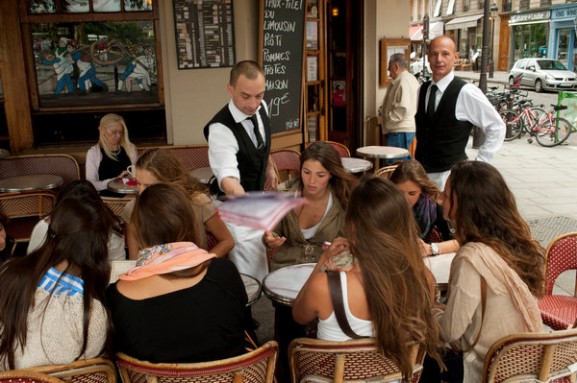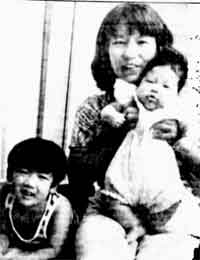A recent New York Times article, “A Quest to Make Gruff Service in France More Gracious” http://www.nytimes.com/2013/08/21/world/europe/can-the-gruff-frenchman-become-the-gracious-frenchman.html?pagewanted=all talks about French waiters’ penchant for being curt and sometimes just appearing plain rude. Then it mentions the Brasserie de l’Isle St. Louis. It also made me think of Yves Montand in the 1983 Claude Sautet movie, Garçon in which the great French actor and entertainer is an aging waiter who still dreams of becoming a singer though working in a cafe most of his life.
When living and working in Paris in the 1970s I would go to the Brasserie de l’Isle St. Louis whenever I had enough money to spend on a nice meal. It was right across the Seine from the flying buttresses at the rear end of Notre Dame cathedral. They served room-temperature brown ale on tap, and I loved their choucroute garnie, their wonderful cassoulet, and in Spring they had a salade called “pis en lit” (piss in your bed), made up of young dandelion leaves, a white vinegar and bacon fat dressing, and thick lardons, thick Canadian-style bacon. So tasty.
I speak French so I never had any questions. But I imagine that French waiters get some pretty dumb questions. “Is the baguette gluten-free? Is there any dairy in the soup?” No wonder the waiters get impatient and gruff. I can’t say I blame them.
Below, a picture of the Brasserie and of Yves Montand. And of the dishes I enjoyed so much there!







A recent New Yorker Magazine featured an article called “Last Call: A Buddhist Monk Confronts Japanese Suicide Culture“. It’s a fascinating story of a young Monk’s struggle to prevent suicides there, not an easy task for anybody including a trained Zen monk. I was reminded of several things, first my reading of Goethe’s epistolary novel The Sorrows of Young Werther, where (if I recall correctly, it’s been a while) the young lovers plan and carry out a double suicide. This was in the early 19th century, and when the novel got to Japan there were many copy cat suicides by young people smitten by the romantic ending.
But I was also reminded of another incident that happened closer to home. In the mid-1980s a young Japanese mother took public transportation to Santa Monica Beach north of the Santa Monica Pier, walked into the water and drowned her children, then attempted but failed to take her own life, mainly because a beach goer ran into the water and rescued her. It was in early spring and not every lifeguard tower was open like in the Summer months. I know this because I was an LA County Beach Lifeguard for many years, and worked that beach.
In the article we read that in traditional Japanese thinking the mother is bonded with her children and if she commits suicide it is immoral to leave her children motherless. In the New Yorker piece, we read that “suicidal parents have killed their children, so as to not to abandon them to an orphan’s life; by tradition, a mother who killed herself but not her children was thought to be truly wicked (p.58). The case of Fumiko Kimura was tried in Santa Monica Municipal Court and I followed it in the LA Times articles that tracked it. Ultimately the woman was not charged with infanticide but rather freed, the presiding judge taking in cultural context into the decision. There was also the interesting fact that the woman’s husband was having an extramarital affair, and his lover came to the couple’s apartment offering to take her own life as a gesture of ultimate shame.
I also remember the little fact that after the spurned mother heard this confession, she made her husband dinner, drew a bath and washed his feet and served dinner. It was the next day that she took her children on the MTA bus to Santa Monica Beach.
She returned to Japan to undergo therapy and I have no idea what happened to her after that.
Below is a link to the fascinating New Yorker article by Jarissa MacFarquhar:
http://www.newyorker.com/reporting/2013/06/24/130624fa_fact_macfarquhar
Here is a link to the 1985 Los Angeles Times article about the incident:
http://articles.latimes.com/1985-02-24/news/mn-24484_1_criminal-charges
When I was 12 and 13, cycling was everything to me. I rode around 100-150 miles weekly, was on an informal team called “Le Voyageurs” (The Travelers), complete with jerseys, chamois-seated shorts, toe clips, the whole deal. A weekend ride would have us all ride from Santa Monica Canyon up PCH to Malibu Canyon Road, then up to Mulholland, and out to Malibu Lake. Then back home again. It was a long ride. The ultimate prize was going up Tuna Canyon road, just north of Topanga Canyon, without getting up off the saddle. I subscribed to a UK magazine called Sporting Cyclist, reading about the Saeco and St. Raphael Geminiani teams, the great Louis Bobet, Jacques Anquetil, and the disgraced UK cyclist Tom Simpson, who was busted for doping. Yes, I’m dating myself….this was a long time ago. This was before I went beserk for surfing.
One day, driving with my mother down Lincoln Boulevard near Westchester’s LMU, we stopped at a bike store where I beheld a beautiful Italian racing bike….a Legnano. It was all-Campy–all Campagnolo components, then the Dom Perignon of derailleurs, brakes, head stems, seat posts, chain sets. Beautiful Italian duraluminum that could have been designed by Leonardo da Vinci. I lusted and longed for that bike. It cost $199.00. My mother said no and I remained stuck with my older brother’s hand-me-down. Later I saved lunch money for three months and bought a Raleigh Grand Prix. But I never forgot the Legnano. It was the bike that got away.
It reminded me of a story I heard once on NPR: a kid who wanted a certain baseball glove for Christmas. He cut out pictures and showed them to his parents. He made it clear that this was the glove he wanted….it had some famous player’s name on it. Christmas came, and the little guy was almost peeing in his pants as he opened a square package smelling of neats foot oil, the stuff they put on baseball gloves. He opened the box and ! was devastated. Instead of the prized $20 glove, it was a cheap knock-off that his parents bought for five dollars. For them it was all the same. For him it was completely different, and painful.
Don’t ask me why, but I looked up this coveted Italian bike that never was, and found a link. Here it is: even in the same chartreuse color I remember so well:
http://www.biciclassiche.com/2013/02/legnano-roma-olimpiade-1960-61.html








